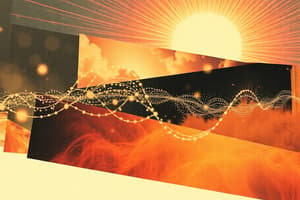Podcast
Questions and Answers
What is the source of energy stored in the bonds between atoms in molecules?
What is the source of energy stored in the bonds between atoms in molecules?
- Radioactive elements
- Fossil fuels
- The Sun's radiation (correct)
- Earth's core
What is the ultimate driver of the evolution of human beings?
What is the ultimate driver of the evolution of human beings?
- Radioactive elements
- Fossil fuels
- Earth's gravity
- The Sun's radiation (correct)
What is the process by which radioactive elements release energy?
What is the process by which radioactive elements release energy?
- Fusion
- Nuclear decay (correct)
- Electromagnetic induction
- Fission
What is the purpose of densely packed radioactive samples in nuclear power plants?
What is the purpose of densely packed radioactive samples in nuclear power plants?
What is the final form of energy emitted by lightbulbs and screens?
What is the final form of energy emitted by lightbulbs and screens?
What is the source of fossil fuels?
What is the source of fossil fuels?
What is the product of the conversion of fossil fuels in nuclear power plants?
What is the product of the conversion of fossil fuels in nuclear power plants?
What is the mechanism by which turbines produce electricity in nuclear power plants?
What is the mechanism by which turbines produce electricity in nuclear power plants?
What is the origin of radioactive elements?
What is the origin of radioactive elements?
What is the transformation of fossil fuels into radiant energy an example of?
What is the transformation of fossil fuels into radiant energy an example of?
What is the primary source of energy stored in the bonds of molecules?
What is the primary source of energy stored in the bonds of molecules?
What is the final destination of the energy released from fossil fuels?
What is the final destination of the energy released from fossil fuels?
What is the purpose of nuclear reactions in nuclear power plants?
What is the purpose of nuclear reactions in nuclear power plants?
What is the ultimate source of energy in fossil fuels?
What is the ultimate source of energy in fossil fuels?
What is the role of densely packed radioactive samples in nuclear power plants?
What is the role of densely packed radioactive samples in nuclear power plants?
What is the end product of electricity generation in nuclear power plants?
What is the end product of electricity generation in nuclear power plants?
What is the origin of the energy released by radioactive elements?
What is the origin of the energy released by radioactive elements?
What is the process by which fossil fuels are converted into radiant energy?
What is the process by which fossil fuels are converted into radiant energy?
What is the role of turbines in nuclear power plants?
What is the role of turbines in nuclear power plants?
What is the transformation of fossil fuels in nuclear power plants an example of?
What is the transformation of fossil fuels in nuclear power plants an example of?
Flashcards are hidden until you start studying
Study Notes
Radiant Energy
- Radiant energy is energy transferred by electromagnetic waves and gravitational waves, which can travel through the vacuum of space.
- Electromagnetic waves and gravitational waves are different from other waves like sound waves or water waves, as they do not require a medium to transfer energy.
Measurement of Radiant Energy
- The SI unit of measurement for radiant energy is the joule (J).
- Radiant energy can be measured using radiometric techniques, which involve using radiometers to measure the radiation flux or power in watts or joules per second.
Electromagnetic Radiation
- Electromagnetic radiation can be thought of in two ways: a stream of photons or fields of oscillating waves.
- In classical physics, electromagnetic radiation exists as electromagnetic oscillating waves, which are the result of periodic changes in electric or magnetic fields.
- In quantum mechanics, electromagnetic radiation consists of photons, which have no mass while at rest, and the energy level increases with the frequency of the photon.
- The relationship between energy and frequency in a photon is provided by Planck's equation: E=hf.
Electromagnetic Spectrum
- The electromagnetic spectrum consists of different waves or photons oscillating at different frequencies.
- The electromagnetic spectrum, from lowest to highest frequency, includes:
- Radio waves
- Microwaves
- Infrared light
- Visible light
- Ultraviolet light
- X-rays
- Gamma rays
Gravitational Radiation
- Gravitational radiation is a disturbance that propagates through spacetime from its source, at the same speed as electromagnetic radiation (~300,000,000 meters per second).
- Gravitational waves are a prediction of Albert Einstein's general theory of relativity and were directly detected and measured in 2015 by the Laser Interferometer Gravitational-Wave Observatory (LIGO) and the Virgo Interferometer.
Uses of Radiant Energy
- Radiant energy is used in:
- Radio astronomy
- Optical astronomy
- Telecommunications
- Solar energy collectors
- Thermal heating lamps
- Lighting
- Screens (e.g. TVs, computers)
- Nuclear fusion
- Medical examinations (e.g. X-rays)
- Cancer treatment
Collection of Radiant Energy
- Radiant energy can be collected from:
- The Sun
- Stars
- Supernovae
- Nuclear fusion
- Underwater volcanoes
- Radioactive elements
Evolution and Life on Earth
- The Sun's radiant energy is stored in the bonds between atoms, as chemical energy in molecules.
- Life on Earth evolved to utilize the Sun's radiant energy through photosynthesis.
- The Earth's biomass is a product of the Sun's radiation being stored in the bonds between atoms.
- Fossil fuels are a product of the Sun's radiation being stored in the bonds between atoms, and are used to produce radiant energy.
Radiant Energy
- Radiant energy is energy transferred by electromagnetic waves and gravitational waves, which can travel through the vacuum of space.
- Electromagnetic waves and gravitational waves are different from other waves like sound waves or water waves, as they do not require a medium to transfer energy.
Measurement of Radiant Energy
- The SI unit of measurement for radiant energy is the joule (J).
- Radiant energy can be measured using radiometric techniques, which involve using radiometers to measure the radiation flux or power in watts or joules per second.
Electromagnetic Radiation
- Electromagnetic radiation can be thought of in two ways: a stream of photons or fields of oscillating waves.
- In classical physics, electromagnetic radiation exists as electromagnetic oscillating waves, which are the result of periodic changes in electric or magnetic fields.
- In quantum mechanics, electromagnetic radiation consists of photons, which have no mass while at rest, and the energy level increases with the frequency of the photon.
- The relationship between energy and frequency in a photon is provided by Planck's equation: E=hf.
Electromagnetic Spectrum
- The electromagnetic spectrum consists of different waves or photons oscillating at different frequencies.
- The electromagnetic spectrum, from lowest to highest frequency, includes:
- Radio waves
- Microwaves
- Infrared light
- Visible light
- Ultraviolet light
- X-rays
- Gamma rays
Gravitational Radiation
- Gravitational radiation is a disturbance that propagates through spacetime from its source, at the same speed as electromagnetic radiation (~300,000,000 meters per second).
- Gravitational waves are a prediction of Albert Einstein's general theory of relativity and were directly detected and measured in 2015 by the Laser Interferometer Gravitational-Wave Observatory (LIGO) and the Virgo Interferometer.
Uses of Radiant Energy
- Radiant energy is used in:
- Radio astronomy
- Optical astronomy
- Telecommunications
- Solar energy collectors
- Thermal heating lamps
- Lighting
- Screens (e.g. TVs, computers)
- Nuclear fusion
- Medical examinations (e.g. X-rays)
- Cancer treatment
Collection of Radiant Energy
- Radiant energy can be collected from:
- The Sun
- Stars
- Supernovae
- Nuclear fusion
- Underwater volcanoes
- Radioactive elements
Evolution and Life on Earth
- The Sun's radiant energy is stored in the bonds between atoms, as chemical energy in molecules.
- Life on Earth evolved to utilize the Sun's radiant energy through photosynthesis.
- The Earth's biomass is a product of the Sun's radiation being stored in the bonds between atoms.
- Fossil fuels are a product of the Sun's radiation being stored in the bonds between atoms, and are used to produce radiant energy.
Studying That Suits You
Use AI to generate personalized quizzes and flashcards to suit your learning preferences.




